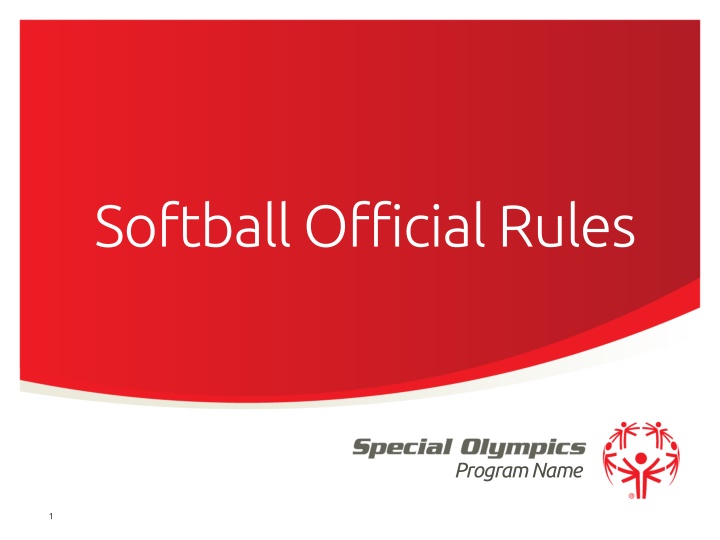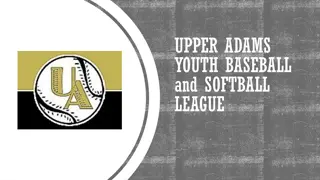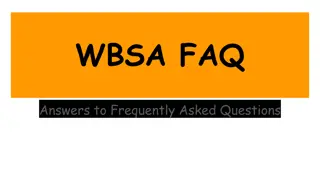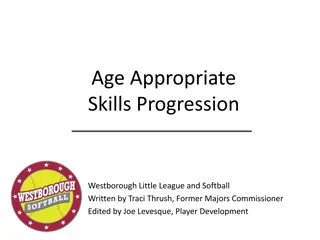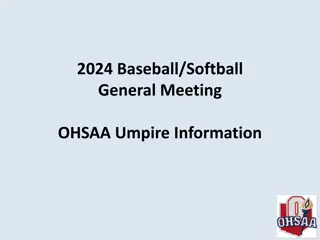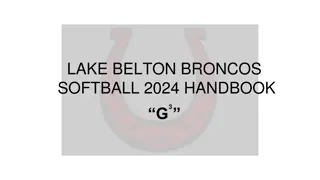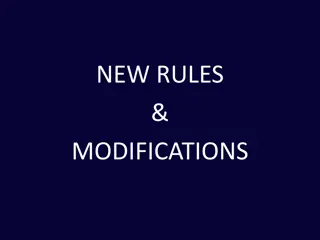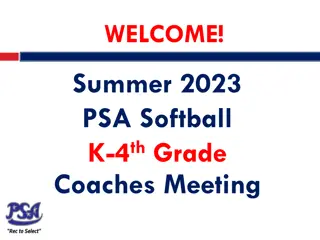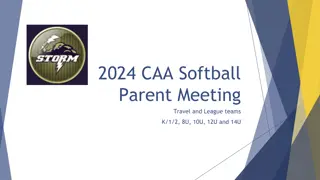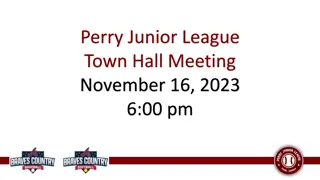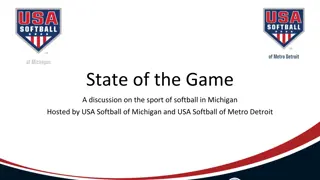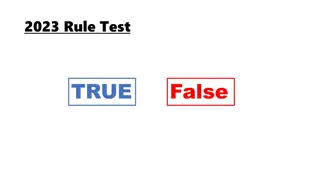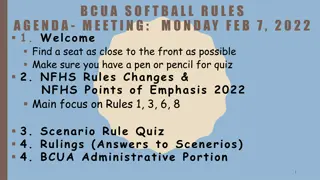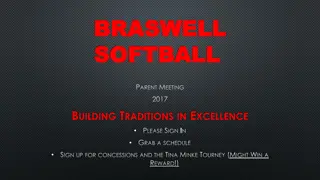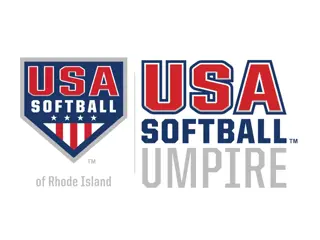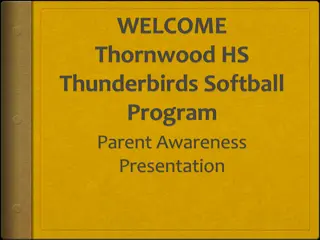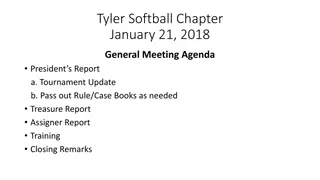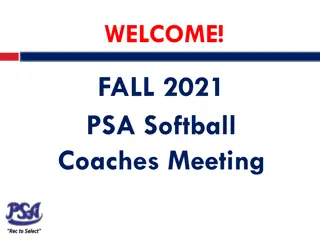Guidelines and Regulations for Softball Events
Discover essential guidelines and rules for softball competitions, including uniform requirements, equipment regulations, and ball specifications. Learn about the events offered, team competitions, and individual skills contests in the softball program. Ensure compliance with uniform guidelines and equipment standards to participate in the exciting sport of softball.
Download Presentation

Please find below an Image/Link to download the presentation.
The content on the website is provided AS IS for your information and personal use only. It may not be sold, licensed, or shared on other websites without obtaining consent from the author.If you encounter any issues during the download, it is possible that the publisher has removed the file from their server.
You are allowed to download the files provided on this website for personal or commercial use, subject to the condition that they are used lawfully. All files are the property of their respective owners.
The content on the website is provided AS IS for your information and personal use only. It may not be sold, licensed, or shared on other websites without obtaining consent from the author.
E N D
Presentation Transcript
Softball Official Rules Program Name 1
A picture paints a thousand words A picture paints a thousand words Let me win, but if I cannot win, let me be brave in the attempt. Use the Picture and Caption format to create strong compelling slide like this. Don t t forget to caption where possible. For best effect crop the image to fill the placeholder. 2
The Basics Sport season: June September Culminating State Events: State Fall Games Alpine Skiing
Events Offered Team Competition Slow Pitch Unified Team Competition Slow Pitch Individual Skills Contest T-ball Coach Pitch (Regional/Area Only) 4
Uniform Guidelines and Equipment Uniforms consist of a jersey, shorts, stockings and sport shoes. All team members must have identical uniforms in color and design. The Special Olympics Michigan logo must be on the jersey. Caps, visors, and headbands are optional for players but can be mixed. If more than one type is worn, they all must be of the same color. Alpine Skiing
Uniform Guideline and Equipment Cont. All player pants shall be either all long or all short in style. Rubber soled athletic shoes or rubber cleats must be worn; metal spikes are not. Bandanas, du-rags, jewelry, and denim may not be worn during games or practice. Headwear for religious or medical reasons are acceptable but must be brought to the attention of the Games Director prior to competition. 6
Uniform Guideline and Equipment Cont. Ball Regulations: The completed 30.5cm (12 in) ball shall be between 30.2cm (11 7/8 in) and 30.8cm (12 1/8 in) in circumference, and shall weigh between 178.0g (6 ounces) and 198.4g (7 ounces). Batting helmets are required for all batters and base runners. The catcher must wear a face mask and catcher s type helmet. Chest protectors and throat guards are not required, but recommended. 7
Uniform Guideline and Equipment Cont. If a play is made at first base on any batted ball, and the batter-runner touches only the fair portion, and if the defense appeals prior to the batter runner returning to first base, the batter runner is out. After the batter-runner passes first base, they may return to either portion of the double base and may stand on either portion for the beginning of subsequent plays. 8
Official Bat Shall be of one-piece construction, multi-piece permanently assembled or two piece interchangeable construction. If the bat is designed with interchangeable components it must meet the following criteria. Shall not be more than 86.4cm (34 in) long, nor exceed 1077.0 g (38 ounces) in weight. Shall be made of hardwood, metal, bamboo, plastic, graphite, carbon, magnesium, fiberglass, ceramic, or any other composite material approved by the ISF Equipment Standards Commission or NGB Standards. 9
Team Size Team rosters shall contain a minimum of 11 players and a maximum of 15 players. May register 3 athletes as alternates. A team may start a game with 10 players and if an injury or ejection occurs, may finish with 9 players. Games may not begin with 9 players, in this case a forfeit will be declared. All coaches are required to turn in 3 scores prior to the state event, in which their roster must be the same for all 3 scores 10
General Rules Program Name 11
General Rules General Rules A game will consist of 7 innings A time limit of one hour and five minutes will be utilized for all games. No new inning can begin after this limit. A game will be deemed complete if a team has a 15 run lead after four innings or 12 runs after 5 innings. In the case of inclement weather, two complete innings shall be considered a complete game. 12 / Special Olympics Program Name
General Rule Cont. A foul ball following 2 strikes is an out. The batting order cannot change except for the following situations: 1. The Batter is Out When playing shorthanded and it is the dropped player s position in the batting order. 2. If an athlete is ejected, it will be considered an out when his/her time to bat arrives. 3. A new athlete may be added to the bottom of the batting order at any time. Sliding is allowed, but not recommended. No assisted devise allowed during team play. 13
General Rules Cont. There will be no more than two coaches for each team to give words or signals of assistance and direction to the members of their team while at bat. One should be stationed near first base and the other near third base. Each coach must remain in his/her coaches box. 14
Tie Breaker Starting with the top of the 8th inning, or the first inning after the time limit, and each half inning thereafter, the offensive team shall begin its turn at the bat with the player who is scheduled to bat last in the respective half inning being placed on second base. The player who is running can be substituted in accordance with the substitution rules. 15
Pitching Regulations The pitch starts when the pitcher makes any motion that is part of his/her windup after the required stop. The pitcher must deliver the ball toward home plate on the first forward swing of the pitching arm past the hip with an underhanded motion. The pivot foot must remain in contact with the pitcher's plate until the pitched ball leaves the hand. 16
Batting The batting order must show the first and last name, uniform number and the position on the line- up card and must be delivered before the game by the manager or captain to the plate umpire. In Unified, the line-up card shall designate A for athlete and P for partner next to that players information. The batter must have both feet completely within the batter's box prior to the start of the pitch. They may touch the lines, but no part of their foot may be outside the lines prior to the pitch. 17
Batting Cont. A Ball is Called by the Umpire for each legally pitched ball that: Does not enter the strike zone. Touches the ground before reaching home plate. Touches home plate and at which the batter does not swing. 18
Fielding The Infield Fly Rule will be in effect when there are less than two outs and there are runners on first and second or the bases are loaded. The umpire will announce, Infield Fly when one of the above conditions exists and a batter hits a pop- fly in the infield. 19
Players Ten players: pitcher (F1), catcher (F2), first baseman (F3), second baseman (F4), third baseman (F5), shortstop (F6), left fielder (F7), left center fielder (F8), right fielder (F9) and right center fielder (F10). 20
Unified Softball Rules Program Name 21
Unified Softball The roster shall contain a proportionate number of athletes and partners. During competition, the line-up shall never exceed five traditional athletes and five partners at any time. The batting order shall alternate athletes and partners. 22
T-Ball Program Name 23
T-Ball Bases may be modified from a standard distance of 60 feet. The distance from home plate to the pitcher s rubber may be modified from a minimum distance 40ft. A neutral zone will be marked in an arc of 45 feet, 11 1/4 inches from home plate. Any batted ball that does not cross this line will be designated a foul ball. A coaches circle will be located 9 feet, 10 1/4 inches beyond second base and made with a 5 feet, 11 inch diameter. 24
T Ball Cont. Each team must have 10 players to start a game. A batting tee will be placed directly on home plate. All defensive players must stand behind the neutral zone before the ball is hit. They may come into the neutral zone after the ball is hit to field it. If a batted ball does not leave the neutral zone, and the defensive player does not touch it, the ball will be called a foul ball. 25
T- Ball Cont. If the batter has two strikes and fouls off the third attempt, he or she shall be declared out. A regulation game consists of six innings. A time limit of one hour shall be in force for all games. Two base coaches are allowed for the offensive team, one in the first base coach s box and one in the third base coach s box. 26
Individual Skill Contest Program Name 27
Event #1 Base Running Purpose: To measure the athlete's base running ability. Description: Bases are set up like a baseball diamond and positioned 19.81 meters (65') apart. The athlete is instructed to start on home plate and run around the bases as fast as possible, touching each base en route. The time elapsed in seconds is subtracted from 300 to determine the points score 28
Event # 2 Throwing Purpose: To measure the athlete's ability in throwing for distance and accuracy. Description: The player being tested stands behind the restraining line, back far enough to take one or more steps in preparation for throwing. The player has two trials to throw the softball as far and as straight as possible down the throwing line, without stepping over the restraining line. 29
Event # 3 Fielding Purpose: To measure the athlete's fielding ability Description: The athlete will stand between and behind the two cones. The official must throw the ball on the ground to the athlete between the cones. The throw to the athlete must hit the ground before the chalk mark. The athlete may move aggressively toward the ball. Each athlete gets five fielding attempts per trial. Each athlete receives two trials. 30
Event # 4 Hitting Purpose: To measure the athlete's ability to hit for distance when hitting off a batting tee. Description: Standing in a regulation size batter's box (i.e., 2.31 meters (77") by 99 cm (3' 3")), the athlete is instructed to hit the ball off the tee. The athlete receives three attempts. Scoring: The distance of the longest hit shall determine the athlete's final score. The distance of a hit is measured from the batting tee to the point where the ball first touches the ground. The distance is measured to the nearest meter (i.e., 1 meter = 1 point, 45 meters = 45 points). 31
Thank you! Program Name 32
